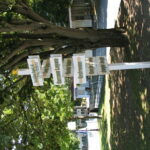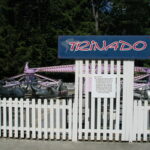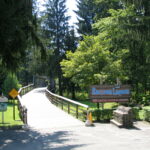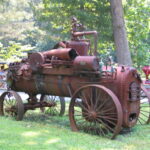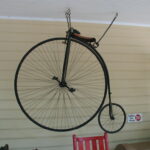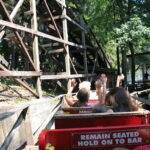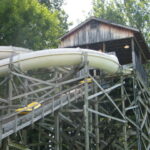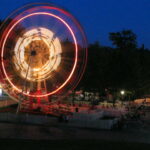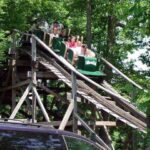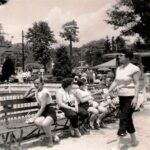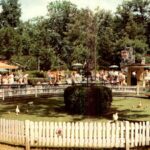Idlewild Park and Soak Zone

Idlewild and Soak Zone, commonly known as Idlewild Park or simply Idlewild, is a children’s amusement park situated in the Laurel Highlands near Ligonier, Pennsylvania, United States, about 50 miles (80 km) east of Pittsburgh, along US Route 30. Founded in 1878 as a campground along the Ligonier Valley Railroad by Thomas Mellon, Idlewild is the oldest amusement park in Pennsylvania and the third oldest operating amusement park in the United States behind Lake Compounce and Cedar Point.[1] The park has won several awards, including from industry publication Amusement Today as the best children’s park in the world.
The park was established by the prominent Mellon family in 1878, and remained family-owned for over 100 years. It expanded greatly throughout the first half of the 20th century, adding rides including a Philadelphia Toboggan Company Rollo Coaster in 1938, one of the company’s earliest. The park is home to the Ligonier Highland Games, a Scottish athletic and cultural festival that has annually drawn over 10,000 spectators. In 1983, the park was purchased by Kennywood Entertainment Company, which oversaw additional expansion, including an attraction designed and voiced by Fred Rogers based on his television show Mister Rogers’ Neighborhood. Since 2008, the park, as well as others formerly under Kennywood Entertainment, have been owned by Spanish company Parques Reunidos and operated by their American subsidiary Palace Entertainment.
Ligonier Valley Railroad: 1878–1952
On April 15, 1853, the Commonwealth of Pennsylvania granted a charter for a railroad to haul coal and timber between the towns of Ligonier and Latrobe. For nearly twenty years, Latrobe and Ligonier Rail Road Company performed no work on the railroad, and renewed their charter in 1866 and 1869. Following an additional renewal in 1871, the company changed its name to the Ligonier Valley Railroad and acquired a 10.3 miles (16.6 km) stretch of land. Land grading and bridge construction for the narrow gauge line was mostly completed by 1873.
In 1875, the partially constructed railway was sold at a sheriff’s sale after the Pennsylvania Railroad, the Latrobe terminus of the line, declined to assume financial responsibility. Thomas Mellon, a retired Court of Common Pleas judge from Allegheny County, purchased the Ligonier Valley Railroad at auction. Mellon had founded the T. Mellon and Sons Bank, and was invested in coal, steel, oil, glassmaking, and other railroad ventures. In an effort to attract passengers, Mellon decided to offer recreational grounds along the route.[3]
On May 1, 1878, William Darlington, landowner and namesake of the nearby village of Darlington, responded to Mellon’s request to use his land:
Dear Sir:
In compliance with your request, I will and do hereby agree to grant to the Ligonier Valley Rail Road Company the right and privilege to occupy for picnic purposes or pleasure grounds that portion of land in Ligonier Township, Westmoreland County as follows – the strip or piece of ground lying between the railway and the creek and extending from the old cornfield to Byards run – also two or three acres on the opposite side of the creek adjoining near the same. Without compensation in the shape of rent for three years from the first of April 1878 provided no timber or other trees are to be cut or injured – the underbrush you may clear out if you wish to do so.
Yours respectfully,
Wm. M. Darlington
The first structure, built that year, was a train depot measuring 10 feet (3.0 m) by 25 feet (7.6 m). The depot was described as the smallest full-service station in the United States.[4] Initial development of the land included camp sites, an artificial lake for fishing and boating, picnic tables, and a large hall. The railroad provided easy access to the site, attracting visitors from 50 miles (80 km) away in Pittsburgh and the surrounding areas for a getaway in the country.[5] The Ligonier Echo noted that on July 4, 1890, the trains to the park were so crowded that the “tops of the coaches were covered with boys.”[6]
While the initial lease with Darlington confined the park to between the railroad and the north bank of the Loyalhanna Creek, permission was later granted for construction of a bridge across the river, allowing expansion to the south in the mid-1880s.[4][7] Three lakes, Woodland, St. Clair, and Bouquet, were dug between 1880 and 1896. In 1896, the park added a T.M. Harton Company steam carousel in the center of the park. The Pittsburgh-based company was a major manufacturer of carousels and roller coasters. By the end of the 19th century, attractions at the park included a bicycle track around Lake Bouquet, a hiking trail on the lake’s island, fishing in the Loyalhanna Creek, rowboating, and many walks and gardens. The park had dining halls, auditoriums, pavilions, a boathouse, an amphitheater, a bandstand, and athletic facilities.[6]
In 1931, Judge Mellon’s son Richard B. Mellon, brother of Andrew Mellon, and C. C. Macdonald acquired the park under a partnership known as the Idlewild Management Company. The first season under the financial support of Mellon and the management of Macdonald and his family brought electricity to the park, allowing for later operating hours and electric-powered rides, including a three-row Philadelphia Toboggan Company carousel.[8] The park also debuted a den of black bears that year. The bears were across the path from a cage of monkeys, who escaped in 1932. Park management offered a reward of $3 each ($55 each in 2019) for the return of the seven monkeys, believing that they had been set loose. R. Z. Macdonald later said that his father, C. C., was always amused and pleased with the publicity that the escape created, though he never formally accused his father.[9]
The Macdonalds sought to maintain the park’s natural beauty, planting 10,000 shrubs in the first year, and thousands of trees during the 1930s. In the first few years, the park added a circle swing, a Whip, a miniature railroad, and in 1938, the Philadelphia Toboggan Company Rollo Coaster. World War II and the resulting rationing forced the park to close in 1943. Upon reopening in 1946, the park added the Caterpillar and a small showboat that sailed in Lake Bouquet.[8]
Macdonald family: 1952–1983
The Macdonald family obtained complete ownership of the park in 1951.[5] After leaving Idlewild, the Mellon family also abandoned the Ligonier Valley Railroad, in decline after the closing of area coal mines and decreased passenger traffic. The railroad ceased operations in 1952. Although the park originally depended on the railroad, its closing had no effect. In 1913, the Lincoln Highway had been established as the first cross-country auto route, stretching from Times Square, New York City, to Lincoln Park, San Francisco. It passed directly by Idlewild on what is now U.S. Route 30. As automobile traffic to the park increased, several parking lots and a Gulf Oil gas station, a Mellon company, were added in the 1930s.[8]
Under the Macdonalds, the park continued to expand. Kiddieland was constructed between 1954 and 1956, and featured many smaller version of rides meant for children. Some of the rides included miniature boats, a Ferris wheel, doodlebug, and pony rides.
Clinton “Jack” Macdonald became president of the park in 1957. In 1959, Macdonald and Lewis Davidson, a bagpipe director at the Carnegie Institute of Technology, started the Ligonier Highland Games, a Scottish highland games event held at the park. During the same year that he assumed control of the park, Macdonald was appointed as the first commissioner of the Scottish Clan Donald for Pennsylvania. The games, held annually in early September after the park had closed for the summer, became one of the largest and most highly regarded Scottish athletic and cultural competitions in the country.[11] Jack Macdonald said of the Games: “We’re not interested in becoming one of the biggest Games. We just want to be one of the nicest.”[11]
The park sustained heavy damage when the remnants of Hurricane Agnes dropped 14 inches (360 mm) of rain on the area in 24 hours in June 1972. Lake St. Clair and Lake Bouquet, merging in the resulting flood, caused significant damage to the boathouse. The flood lifted and twisted the park’s Loyalhanna Limited Railroad, which required extensive repairs.[12]
Kennywood era: 1983–2007
On January 27, 1983, Kennywood Park Corporation of West Mifflin, Pennsylvania, near Pittsburgh, bought the park from the Macdonald family for a reported price of $1.8 million.[1] Ironically, both Kennywood and Idlewild were founded as amusement parks by the Mellon family. During the first winter, several changes occurred. Jumpin’ Jungle, a children’s play area, was added. Story Book Forest was no longer run as a separate operation and was merged with the rest of the park. What had been Historic Village was relocated and renamed.
As the popularity of waterparks increased, the H20hhh Zone was added in 1985. In 1989, the park expanded across the Loyalhanna Creek by adding a trolley ride based on Mister Rogers’ Neighborhood, a popular children’s television show. The ride was designed and voiced by children’s entertainer Fred Rogers, a native of Latrobe. The area was expanded the following year to include Raccoon Lagoon, an area for children. A Ferris wheel, Tilt-A-Whirl and a water raft ride were added by the end of the 1980s, along with games, new food stands and restaurants.[13]
The 1990s brought the addition of the Wild Mouse, the only Wild Mouse roller coaster designed by Dutch company Vekoma. The roller coaster was built in 1985 and had previously operated at Wiener Prater in Austria and Alton Towers in England, before opening at Idlewild in 1993. Kennywood continued the Macdonald tradition of offering large-scale entertainment, presenting circuses, lumberjack and acrobatics shows, and stage performances at the new Hillside Theater. A large picnic area with several log pavilions and game fields was added in 1999. In the early years of the 21st century, additions to the waterpark doubled its size and led to a new name, Idlewild and Soak Zone.
Palace Entertainment, since 2008
Kennywood Entertainment, itself an operator of a family-owned park, had acquired other family-owned and operated parks after its purchase of Idlewild in 1983. Kennywood’s owners rejected offers by larger companies to purchase the group, such as one in 1997 by Premier Parks, the company that acquired the Six Flags franchise a year later. Kennywood refused the Premier offer and others on grounds that the new owners would make too many changes to the existing parks. However, on December 11, 2007, Kennywood Entertainment announced that it would sell its parks to the Madrid-based amusement company, Parques Reunidos. The fourth- and fifth-generation family ownership of Kennywood ensured that with the transaction all of the company’s parks would experience few changes and that day-to-day park operations would remain local.[15]
In December 2009, Idlewild announced that the Royal Hanneford Circus would perform at the park during the 2010 season, for the first time since 1997.
For the 2011 season, the park announced that they would replace their swimming pool—built in 1931—with a $2 million wave pool. The project will be the largest capital improvement undertaken by the park. The pool will be zero-entry to a maximum 6 feet (1.8 m) deep and hold 280,600 gallons.
During interim time between the 2013 and 2014 seasons, it was announced that the park had permanently closed their popular attraction, Mister Rogers’ Neighborhood of Make-Believe. The attraction was re-themed, in coordination with The Fred Rogers Company to the much more relevant and popular spin-off of the classic children’s program Mister Rogers’ Neighborhood, Daniel Tiger’s Neighborhood. The re-themed attraction opened for 2015 season.
On August 11, 2016, a three-year-old boy was thrown from the Rollo Coaster. The boy sustained injuries and was rushed to a Pittsburgh hospital by helicopter, where he was listed in critical condition with head and chest injuries. The boy was in the hospital for two months before being released. The ride was closed pending an investigation and remained closed the remainder of the season, and all of the 2017 season. In May 2017, the Pennsylvania Department of Agriculture, Division of Rides and Amusements released its investigative report, detailing how the riders switched seats after ride operators checked them, resulting in the riders not meeting the rider height requirements. In addition, the report noted several instances of excessive wear and movement of the train hitches and tracks, but that it wasn’t known whether these factors caused the accident. The report listed several requirements for the ride to be reopened, including the addition of seat belts, a reevaluation of minimum rider height, and a ride evaluation by a Professional Engineer. Based on this report, the state also recommended amusement parks with similar roller coasters voluntarily make take the same actions. Idlewild announced they had procured a new train for the Rollo Coaster, which included seat belts, and that they expected the ride to resume operation for the 2018 season, pending a state inspection.[25]
Location
The park is situated alongside U.S. Route 30, also historically known in Pennsylvania as the Lincoln Highway, the first US transcontinental highway. The region surrounding the park is the Laurel Highlands, and the park sits in the foothills of the Laurel Ridge.
The region was prominent in the French and Indian War with Fort Ligonier located just 2 miles (3.2 km) away. On November 12, 1758, volunteers led by George Washington marched from Ligonier to aid George Mercer and his troops. At night in heavy fog, the two units mistook one another for the enemy and exchanged fire. Thirteen soldiers and one lieutenant were killed. Realizing the mistake, Washington ran amongst both groups, shouting and raising the men’s rifles into the air. Washington later wrote of the incident that he never felt in more danger in his life. Though the location had never been entirely verified, in Images of America: Idlewild, author Jeffrey S. Croushore acknowledges the opinion that the event took place in a section of Idlewild that was previously a wooded area known as the Woodlands.[26][27]
Attractions
A sign at the carousel, identifying it as Philadelphia Toboggan Company No. 83
Olde Idlewild[edit]
Olde Idlewild is centered on the park’s Philadelphia Toboggan Company Carousel, (PTC #83) built in 1930 and brought to Idlewild in 1931. The Carousel’s music is provided by two band organs: an Artizan Style D (fitted with a Wurlitzer #103 roll frame as Wurlitzer rolls are more common than Artizan rolls) which is nicknamed “The Wurlitzan” and a Wurlitzer Caliola. The music of these two organs, which are played on a regularly alternating basis, can be heard throughout Olde Idlewild and the lower parking areas. Olde Idlewild contains many of the park’s traditional amusement rides. On the parking lot side of the Merry-Go-Round is the wooden Rollo Coaster, built by Philadelphia Toboggan in 1938 with lumber from the park, using a sawmill built nearby specifically for the project.[8] The American Coaster Enthusiasts named the Rollo Coaster a “Classic Coaster”.[28] Sitting in the trees adjacent to the Loyalhanna Creek is the Wild Mouse, added in 1993. The Wild Mouse was built by Vekoma and operated at Alton Towers in Staffordshire, England, before being moved to Idlewild in 1993.[29] The Scrambler, the Flying Aces, and the Tilt-A-Whirl also surround the Merry-Go-Round.[30]
Another group of rides in Olde Idlewild is located around the park’s Skooters, added in 1931. Surrounding the Skooters is the Balloon Race, Paratrooper, Ferris wheel, and Spider. Below the Paratrooper on the north bank of the Loyalhanna are the Whip, built in 1938, and the Super Round Up.[30] The Whip is closed indefinitely for repair.
Olde Idlewild contained a Caterpillar ride until 2013. Built in 1947, Idlewild’s model was one of three similar rides still in operation in North America, one of two featuring a working canopy that covers the riders, and the only one that still utilized an undercarriage fan.[31] The ride was removed to be refurbished and returned in the future.
Hootin’ Holler
In 1976, the Historic Village was built to commemorate the United States Bicentennial. Modeled after a typical 19th century Western town, the area included a general store, blacksmith and wood shops, sheriff’s office and jail, newspaper office, saloon and restaurant.[32]
In 1984, Historic Village was relocated from near the gates to the center of the park, and renamed Hootin’ Holler.[13] The area contains Confusion Hill, a themed walkthrough tour with optical illusions.[30] The park’s 2 ft (610 mm) narrow gauge[33] Loyalhanna Limited Railroad attraction crosses the Loyalhanna Creek to Raccoon Lagoon and back. The area’s newest rides are the Howler, a spinning ride modeled like a tornado, and Paul Bunyan’s Loggin’ Toboggan, a log flume ride.
Soak Zone
The location of the Soak Zone was originally an island known as Flower Island, until part of the surrounding lake was filled in. Under previous names it was called the H20hhh Zone and later Dr. Hydro’s Soak Zone. The area originally consisted of just the pool and bathhouse, until slides were first added in 1985. A raft ride, Rafter’s Run, was added the next year.[34] The water park has since been expanded to include body slides, inner-tube slides, a slide with foam mats, and many features for children, including a miniature pool and Captain Kidd’s Adventure Galley, a play area added in 2006.[30] The swimming pool was replaced by a heated wave pool in 2011. The addition was the park’s single-largest capital improvement.[35] For the 2013 season the park added a lazy river and an expanded beach area.[36]
Jumpin’ Jungle
Added in 1983, Jumpin’ Jungle is an interactive play area for both children and adults. The area includes many attractions such as a ball pit, slides, climbing nets, and a suspension bridge.[30] Added in 2008, Bigfoot’s Mudslide gets its name from Westmoreland County’s reputation for the most sightings in Pennsylvania of Bigfoot, an alleged ape-like creature said to inhabit remote forests.[37]
Raccoon Lagoon
Animatronic characters at Mr. Rogers’ Neighborhood attraction
The park’s kiddieland area, Raccoon Lagoon, was added in 1989, after originally opening in a different location in 1954. The 9-acre (3.6 ha) area devoted to children-oriented rides is one of the largest in the United States.[30] Also in Raccoon Lagoon was Mister Rogers’ Neighborhood of Make-Believe. Built in 1989, the 3 ft (914 mm) narrow gauge trolley ride was designed specifically for Idlewild by local native Fred Rogers and is based on his popular children’s television show.[13] Prior to the 2014 season, it was announced that the ride would be re-themed in coordination with Fred Rogers Productions to their modern children’s show, Daniel Tiger’s Neighborhood, based on the original series. The newly enhanced attraction, now named the Daniel Tiger’s Neighborhood Trolley Ride, re-opened in 2015.[38]
Story Book Forest
Arthur Jennings, who portrayed the clown “Happy Dayze” in the park during the 1950s, was an accomplished engineer who approached park management about creating Story Book Forest, a theme park based on “emotion rather than motion”.[39] Jennings did much of the work himself, including life-sized models of fairy tales. The park, originally separate from Idlewild, opened in 1956.[40] Story Book Forest featured many attractions such as a pirate ship, a castle, and many live storybook characters.[41] The entrance to the Forest is a giant storybook which reads “Here is the Land of Once Upon a Time … Step through the pages of this big Story Book … and visit the people and places every child knows … and Loves. Here dreams are real … and so are your Story Book friends.”[42] Now incorporated with the rest of the park, Story Book Forest celebrated its 50th anniversary in 2006.[43]
Ligonier Highland Games
The Ligonier Highland Games is a highland games event that takes place in early September. The events primarily take place at Idlewild, while some events also take place in nearby Greensburg. Competitions include heavy athletics such as the caber toss, stone put, and weight and hammer throw. Other competitions in music include highland dancing, solo and band piping, drumming, Scottish fiddling, and Scottish harp. Vendors sell related items such as authentic tartans, bagpipes, and jewellery. While initially attracting crowds of 1,200, the festival now records average attendances near 10,000.




